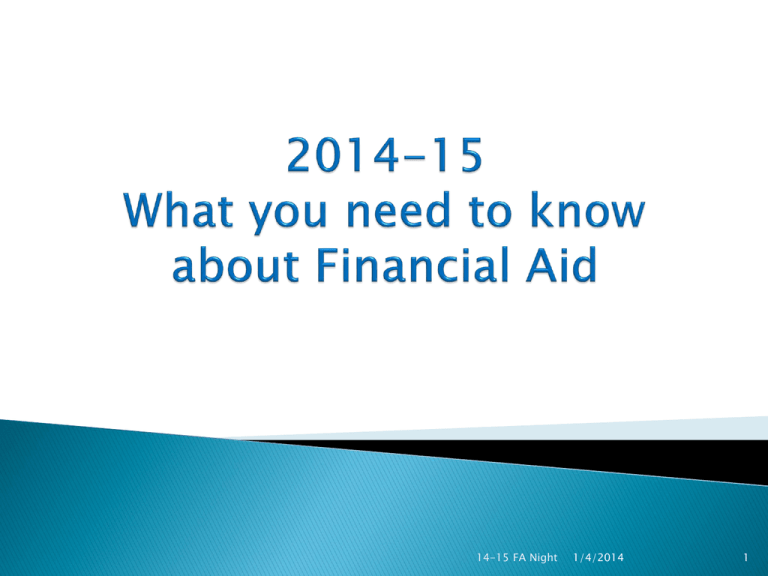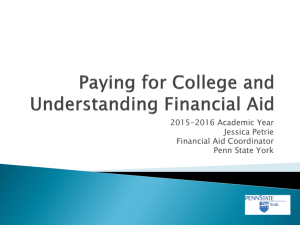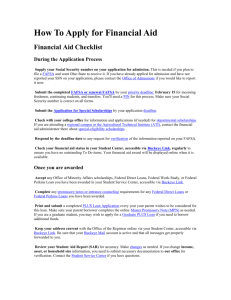Financial Aid Presentation
advertisement

14-15 FA Night 1/4/2014 1 Free Application for Federal Student Aid (FAFSA) IRS Data Retrieval Tool Special Circumstances Cost of Attendance and EFC Categories, types, and sources of financial aid Collects family’s personal and financial information used to calculate student’s EFC Amount of money a student and his or her family may reasonably be expected to contribute towards the cost of the student’s education for an academic year Completed each year after January 1st Use IRS Data Retrieval to download income information from your 2013 Federal Tax Return However, most W-2s will not be available until the end of January ◦ IRS will not start accepting and processing the Federal Tax Forms until sometime between January 28 and February 4, 2014. ◦ From what we hear IRS Data Retrieval will be available starting February 2, 2014 ◦ If the student and parent file electronically, IRS Data Retrieval would be available 2 weeks after they filed ◦ If the student and parent file by paper, IRS Data Retrieval would be available 6-8 weeks after they filed Website: www.pin.ed.gov Sign FAFSA electronically Not required, but speeds processing May be used by students and parents throughout aid process, including subsequent school years Definition of Marriage: For both students and parents-marriage now includes a same sex couple who are married under the authority of a state (or foreign country) that permits same-sex marriage, even if the state (or foreign country) in which they now live does not recognize same-sex marriage. Never Married Unmarried and both parents living together Biological Parents or Same Sex Parents (regardless of state authority related to marriage) should use this response if appropriate Married or Remarried Divorced or Separated Widowed Biological parents Adoptive parents Stepparents, if they are married to the student’s biological or adoptive parent and the student is included in their household size Foster parents Legal guardians who have not adopted the student Relatives who have not adopted the student Stepparents who have not adopted the student and who would be the only person providing parental information While completing FAFSA, student and parent may submit real-time request to IRS for tax data IRS will authenticate taxpayer’s identity Need to remember the exact address and spelling of names on the Federal Tax Return If match found, IRS sends real-time results to applicant in new browser window Applicant chooses whether or not to transfer data to FAFSA Available early February 2014 for 2014–15 processing cycle Participation is voluntary Reduces documents requested by financial aid office A student or parent who cannot remember the address used on their 2013 Federal Tax Return. Marital Status-Unmarried and both parents living together A married student or married parents who did not file joint returns but instead filed separate tax returns A married student or married parent who files as Head of Household is not eligible to use the IRS Data Retrieval tool ◦ This would mean they filed separate tax return ◦ However, a single student or single parent who files as Head of Household is eligible to use the IRS Data Retrieval tool A student or parent(s) who had a change in marital status after December 31, 2013 The student or parent(s) filed and amended tax return Students and parent can start completing their FAFSA In order to use the IRS Data Retrieval Tool the Federal Tax Return has to be completed and processed by the IRS ◦ However, most W-2s will not be available until the end of January ◦ IRS will not start processing the Federal Tax Forms until sometime between January 28 and February 4, 2014. ◦ If the student and parent file electronically, IRS Data Retrieval would be available 2 weeks after they filed ◦ If the student and parent file by paper, IRS Data Retrieval would be available 6-8 weeks after they filed From what we hear IRS Data Retrieval will be available starting February 2, 2014 Confirmation Number Data Release Number (DRN) EFC estimate Pell Grant and Direct Loan estimates Option for parents to transfer parent’s info to another application for another child Option for some states to apply for State Grant CPS notifies student of FAFSA processing results by: E-mail notification containing a direct link to student’s electronic SAR if student’s e-mail was provided on paper or electronic FAFSA Paper SAR sent if no student e-mail provided Student with FSA PIN can view SAR online at www.fafsa.gov Students should review SAR data for accuracy and correct any errors Required to update estimated tax information when actual figures become available Institutional Student Information Record (ISIR) sent to colleges listed on FAFSA approximately 10 to 14 days after FAFSA is submitted College reviews ISIR ◦ May request additional documentation: Verification proof of homelessness or ward of the court status proof that a sibling is enrolled in college ◦ Will generally not send you an award letter unless an Admissions Application has been submitted Students should only correct information that was reported incorrectly when he or she completed the FAFSA Corrections to FAFSA data may be made by: Using FAFSA on the Web (www.fafsa.gov) if student has a FSA PIN Updating and mailing paper SAR Submitting documentation to school’s financial aid office Corrections required if “estimated income” used for initial filing Institutions will call it either Special Circumstances or Professional Judgment Families cannot report special circumstances on the FAFSA Professional judgment exercised after the family files the FAFSA and completes verification (if required) Professional judgment exercised by the financial aid administrator Dependency Override Abuse at home Abandonment by parents Parents Refuse to Provide Information ◦ Student only eligible for Unsubsidized Loan Income Reduction Non-Recurring Income Unusually High Day Care Expenses Unusually High Medical or Dental Expenses Each Institution has their own process Institutional Forms Documentation from third party: Teacher Social worker Member of clergy Court Law enforcement www.fafsa.gov Completing the FAFSA available at: http://studentaid.ed.gov/fafsa 2014/15 FAFSA on the Web Worksheet: http://studentaid.ed.gov/sites/default/files/ 2014-15-fafsa-worksheet.pdf Direct Cost + Indirect Cost = COA Direct costs Tuition Fees Books Room and Board if On Campus Indirect costs Room and Board if Off Campus or With Parent Transportation Personal Expenses COA varies widely from college to college www.fafsa4caster.ed.gov An index used to calculate eligibility for aid Stays the same regardless of college Two components –Parent contribution –Student contribution Calculated using FAFSA data and a formula specified in law Cost of Attendance (COA) – Expected Family Contribution (EFC) = Financial Need Direct Costs School A School B School C Tuition $6,093 $10,368 $11,772 Fees $1,524 $784.74 $410 Books $1,100 $2,200 $1,350 Room (On Campus) $3,060 $4,027 N/A Meal Plan $2,885 $4,244 N/A - Grants $5,645 $5,645 $5,645 - Scholarships $1,500 $4,500 $1,500 Net Price (Out of Pocket or Loans?) $7,517 $11,479 $6,387 Mix of grants and self-help aid Future award packages Gift Aid Scholarships Money that does not have to be paid back Awarded on basis of merit, skill, or unique characteristic Grants Money that does not have to be paid back Usually awarded on the basis of financial need Self-Help Aid Federal Work Study Loans Money students and parents borrow to help pay college expenses Repayment usually begins after education is finished Only borrow what is really needed Look at loans as an investment in the future The Federal Pell Grant Program provides need-based grants to low-income undergraduate students. Grant amounts depend on the student’s: Expected Family Contribution (EFC) Enrollment status (full or part-time) Attendance status (full academic year or less) Pell Grant maximum award per academic year: $5,645 (2013-2014) Maximum award may be subject to change pending legislative budgetary adjustments * The Federal Supplemental Educational Opportunity Grant (FSEOG) Program provides need-based grants to low-income undergraduate students (campus-based aid). Grant recipients must be: Pell Grant-eligible Current award amounts are from $100 - $4,000 Not all colleges participate in the FSEOG program and funds depend on availability at the college The Teacher Education Assistance for College and Higher Education Grant Program (TEACH) provides assistance to students who intend to teach in a public or private elementary or secondary school that serves students from low-income families. Grant recipients must be: Enrolled in an institution that participates in the TEACH Grant Program Enrolled in coursework that is necessary to being a career in teaching Able to demonstrate certain academic achievements The Teach Grant: Is not based on financial need Is available to both undergraduate and graduate students Provides the following maximum award $4,000 (2013-14) TEACH Grant recipients must sign an ‘Agreement to Serve’ which states that the student will: Teach at least four years in a public or private elementary or secondary school Teach full-time in a high-need field Teach in a school that serves students from low-income families If the teaching obligation is not completed, the entire TEACH Grant must be repaid as a Direct Unsubsidized Stafford Loan Students whose parent or guardian died as a result of military service in Iraq or Afghanistan after September 11, 2001, may be eligible for additional Title IV aid. Additional Student Eligibility Requirements: Less than 24 years old Enrolled in college at least part-time at the time of the parent’s or guardian’s death Provides part-time jobs for undergraduate and graduate students with financial need, allowing them to earn money to help pay education expenses (campus-based) Eligible employers (On-campus or off-campus employment) Schools Federal, state or local public agency Private nonprofit organization Community service activities Students are paid at least federal minimum wage Not all colleges participate in the Federal Work-study program and funding depends on availability at the college Your college is the lender Payment is owed to the college that made the loan Interest charged on this loan is 5% Funds depend on financial need and availability at the college Undergraduate students – up to $5,500 a year Graduate and professional degree students – up to $8,000 Not all colleges participate in the Federal Perkins Loan program Subsidized Loans Government PAYS the borrowers accrued interest while you are attending college and other eligible periods Based on Financial Need Fee 1.072% on each loan Interest currently 3.86% Undergraduate students Amount: $3,500-$5,500 If do not complete degree within 150% of the published length of your lose interest subsidy benefits on all Direct Subsidized loans and only eligible for Direct Unsubsidized loans Unsubsidized Loans The borrowers is responsible for the interest for the life of the loan NOT Based on Financial Need Fee 1.072% on each loan Interest currently 3.86% Undergraduate and graduate students qualify Amount: $5,500-$12,500 PLUS loans originate through the William D. Ford Federal Direct Loan Program (Direct Loans). Loan characteristics: For parents of dependent students; parent is the borrower and loan cannot be transferred into student’s name Borrowers may receive loan amounts up to, but not exceeding the college’s ‘Cost of Attendance’ Borrower is responsible for all the interest Borrower must not have a negative credit history (July 1, 2013 to June 30, 2014) * Fee + Interest Rate Repayment Federal Perkins No Fee 5% Fixed 9 Months after school Direct Stafford Loan 1.072% Fee + 3.86% Fixed* 6 months after school Federal Parent PLUS loan 4.288% + 6.41% Fixed* May be deferred until 6 months student drop ½ time or 60 days after loan is fully disbursed Additional Info Subsidized: no interest charged while in school Unsubsidized: interest accrues while in school * Fee & Interest Rates subject to change July 1 each award year http://sdos.sdbor.edu/ Limited number of scholarships available Being designated as a Regents Scholar does not automatically qualify the student for the South Dakota Opportunity Scholarship (SDOS). Amount-$1,000 each year 1st – 3rd, $2,000 4th year Reminder – To establish initial eligibility, the student must complete an application form (now available in electronic format) and submit this to the college he or she will attend. Due Date (complete application package): Recommended: Fall Term-June 1st Spring Term-November 1st Actual Deadline: Fall Term-September 1st Spring Term-January 15st 1. 2. 3. 4. 5. 6. Be a resident of South Dakota at time of high school graduation. Have an ACT composite score of 24 or higher before the beginning of post-secondary education. If using a SAT score, the sum of the verbal and mathematics scores on the SAT must be at least 1090. Complete high school course requirements with no final grade below a "C" (2.0 on a 4.0 scale) and a cumulative high school GPA of 3.0 on a 4.0 scale (grade of "B") prior to graduation (Note: One unit of high school credit equals 1 year of instruction). If ACT composite score is at least 28 and meets the ACT college readiness benchmarks scores equaling or exceeding 18 for English, 21 for Reading, 22 for Math, and 24 for Science, the curriculum requirements specified in section 3 above are not required. Attend a university, college, or technical school accredited by the Higher Learning Commission of the North Central Association of Colleges and Schools and that provides instruction from a campus located in South Dakota. Enter into the program 1. within 5 years of high school graduation 2. within 1 year of the student's release from active duty military service (if that release is within 5 years of the date of the student's high school graduation) 3. transfer from a regionally accredited university, college, or technical school located outside of South Dakota may do so within two years following high school graduation and be eligible to receive partial award. http://www.state.sd.us/dakotacorps/default.html Limited number of scholarships available Graduate from an accredited South Dakota high school with a Grade Point Average (GPA of) 2.8 or greater on a 4.0 scale. Have a composite ACT score of 24 or greater (or the SAT equivalent). Apply for the Dakota Corps Scholarship for a school period that begins within one year of high school graduation, or within one year of release from active duty of an active component of the armed forces. Deadline: applications must be postmarked by February 1st Amount: Amount equal to tuition and fees for 16 undergraduate credits hours (per fall and spring semester) at a SD public four-year college or actual tuition and fees for same time frame and credits whichever is less Attend a participating South Dakota college as an undergraduate student in a program that will prepare the student to work in a critical need occupation. Note: not all South Dakota colleges participate. See website for participating colleges. Be a U.S. citizen or U.S. national. Agree, in writing, to stay in South Dakota and work in a critical need occupation after graduation for as many years as the scholarship was received, plus one year Teacher (HS Math, Science, Career and Technical Education) Teacher (Elementary or Secondary Special Education) Accountant/Auditor Engineer (Except Mining) Information Technology Registered Nurse http://www.sdbor.edu/students/JumpStart.htm ◦ Resident of South Dakota ◦ Student graduates from High School within 3 years or less from a public high school in South Dakota ◦ No student who enrolls in a high school for all or any part of a fourth year is eligible for the Jump Start Scholarship program. ◦ For 2013/14 eligible for $1866.45 for their first year of post secondary enrollment, distributed equally amount the terms of the year ◦ Within one year of graduating from high school, excluding any time served on active duty in the armed forces of the United States, enroll in a college, university, or technical school accredited by the North Central Association of Colleges and Schools that provides instruction from a campus located in South Dakota ◦ Deadline September 1st Complete the Free Application for Federal Student Aid Institutionally awarded Institutions may have their own application Awarded by institution to those students who have the highest amount of unmet need on the campus $500-$2000 per student Student must be a South Dakota resident Maintain Satisfactory Academic Progress Foundation Private nonprofit foundation Created when Education Assistance Corporation affiliated with Great Lakes Higher Ed Corporation http://www.sdeducationaccess.org/ Mission To expand access to postsecondary education Programs Grants to Postsecondary Students College Access Advising Corporation for National and Community Service U.S. Department of Veterans Affairs Reserve Officers Training Corps (ROTC) Bureau of Indian Affairs (BIA) Grants Vocational rehabilitation benefits U.S. Department of Health and Human Services (HHS) Foundations, businesses, charitable organizations, civic organizations, churches, etc. Deadlines and application procedures vary widely Begin researching private aid sources early Your College may also have scholarships available Research what is available in community To what organizations and churches do student and family belong? Application process usually occurs during spring of senior year Small scholarships add up! Companies may have scholarships available to the children of employees Companies may have educational benefits for their employees Employer-sponsored tuition plans Other family resources Home equity loans Private/alternative loans Tuition savings plans (529 plans) Always use free searches! Other resources available Guidelines on when and how to apply Applications, essays, videos, etc. DO NOT PAY FOR A SCHOLARSHIP SEARCH www.fafsa4caster.ed.gov http://studentaid.gov/types/grants-scholarships/findingscholarships http://www.careerinfonet.org/scholarshipsearch/Scholarship Category.asp?searchtype=category&nodeid=22 www.fastweb.com http://www.collegescholarships.org/ http://www.scholarships.com/ http://www.aie.org/paying-for-college/Financial-aid/How-to-Find-MoreScholarships.cfm




